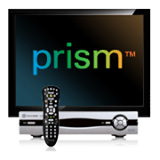 CenturyLink has launched an aggressive new marketing campaign to promote its fiber to the neighborhood service in the greater Omaha area.
CenturyLink has launched an aggressive new marketing campaign to promote its fiber to the neighborhood service in the greater Omaha area.
Prism TV is CenturyLink’s equivalent of AT&T’s U-verse — a fiber-copper network that delivers video, phone, and broadband service to customers over their existing copper phone lines.
Currently available to about one-third of Omaha homes, CenturyLink plans to expand Prism TV to the entire area by early 2016.
CenturyLink has not broadly promoted the service in Omaha because so few homes could buy the service when it soft launched around six months ago. The earliest customers were company employees and those in selected neighborhoods where it was sold door-to-door.
CenturyLink says their early experience with the service proves customers are unhappy with the dominant cable company in the area — Cox Communications.
 Like AT&T, CenturyLink has put its DVR front and center in its marketing efforts. Most cable company DVRs allow two simultaneous recordings — Prism TV supports up to four. The service also introduces the “whole house DVR” concept to customers without an expensive add-on. This feature lets customers pick up watching recorded shows where they left off when switching rooms.
Like AT&T, CenturyLink has put its DVR front and center in its marketing efforts. Most cable company DVRs allow two simultaneous recordings — Prism TV supports up to four. The service also introduces the “whole house DVR” concept to customers without an expensive add-on. This feature lets customers pick up watching recorded shows where they left off when switching rooms.
Cox has responded to the competitive threat by beefing up its own services. The cable company recently introduced a DVR that can record six shows at once, as well as the Cox Contour smartphone/tablet app to watch cable programming on personal devices.
“We’ve been competing with other communications providers for decades and aggressively invest in our infrastructure and technology to ensure that our products are superior,” Cox spokeswoman Gail Graeve told the Omaha World-Herald. “Our customers are looking for viewing options that are both personal and portable, and Contour meets those needs.”
CenturyLink has already upgraded its own viewing app, which now includes more channels and an expansion of live and on-demand content. The newest version allows Prism TV customers to watch two dozen networks while traveling and up to 100 channels while streaming from home. There are versions of the TV Everywhere app for iOS, Android tablets and smartphones, and Amazon’s Kindle Fire tablet.
Prism TV is now available in selected neighborhoods in the city of Omaha, as well as in Bellevue, Ralston, Papillion, La Vista, Springfield, Gretna, the Elkhorn area and in unincorporated Douglas and Sarpy Counties.
Nationwide, CenturyLink ended the third quarter of 2013 with 149,000 Prism TV subscribers in the following areas: La Crosse, Wis.; Columbia and Jefferson City, Mo.; Tallahassee, Fla., various communities in central and southwest Florida where CenturyLink is the local telephone company; Las Vegas; central North Carolina; Phoenix; Colorado Springs and Highlands Ranch, Colo.
Channels Available for Viewing Outside the Home:

CenturyLink offers a $300 rebate to new customers.
- AWE
- Bloomberg
- Cars
- Comedy
- CSPAN
- CSPAN-2
- FearNET
- FOX Business Network
- Fox News Channel
- Justice Central
- MAVTV
- PAC 12 Arizona
- PAC 12 Mountain
- PAC 12 National
- Pets
- Pixl
- Recipes
- Shorts East
- Sony Movie Channel
- Sportsman
- STARZ – East
- STARZ – West
- Travel
- Universal Sports
- World Fishing Network
In-home Viewing Only:
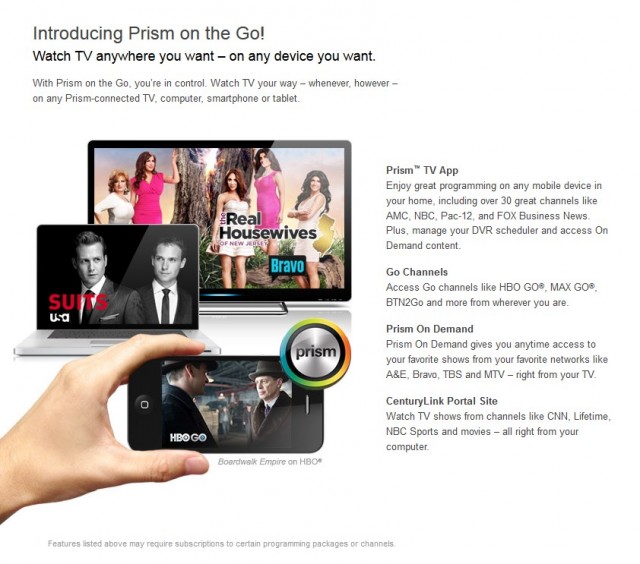 A&E
A&E- AMC
- Animal Planet
- Aspire
- AWE
- BBC America
- BBC World
- Big Ten National
- Biography
- Bloomberg
- Boomerang
- Bravo
- Cars
- Cartoon Network
- Chiller
- Cloo
- CNBC
- CNN en Espanol
- CNN
- CNN International
- Comedy
- CSPAN
- CSPAN-2
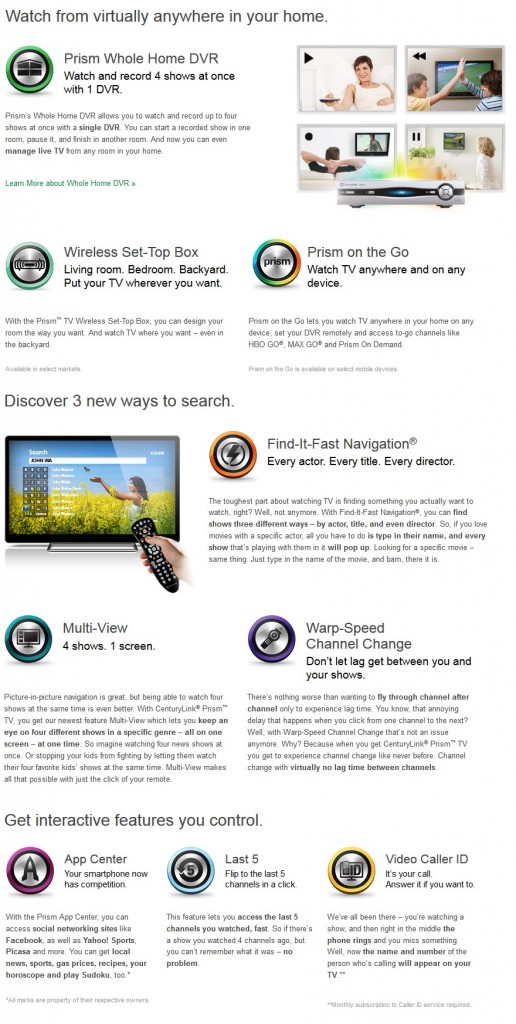 Discovery
Discovery- E!
- ENCORE – East
- ENCORE – West
- Encore Action
- Encore Español
- Encore Suspense
- Esquire TV
- FearNET
- FOX Business Network
- Fox News Channel
- Fox Sports 1
- Fox Sports AZ (Phoenix)
- Fox Sports AZ Plus (Phoenix)
- Fuse
- FX
- FX Movies
- FXX
- G4
- Golf Channel
- H2
- Hallmark Channel
- Hallmark Movie Channel
- HeadLine News
- History
- HRTV
- IFC East
- Indiplex
- Inspiration Network
- Justice Central
- Lifetime
- Lifetime Movie Network
- Lifetime Real Woman
- MAVTV
- MGM
- Movieplex
- MSNBC
- Mun2 West
- National Geographic Channel
- National Geographic Wild
- Oprah Winfrey Network
- Outside
- Oxygen
- PAC 12 Arizona
- PAC 12 Mountain
- PAC 12 National
- Pets
 Pixl
Pixl- Recipes
- Retroplex
- Science
- Shorts
- Smithsonian – East
- Smithsonian – West
- Sony Movie Channel
- Sportsman
- Sprout
- STARZ – East
- STARZ – West
- Starz Black
- Starz Cinema
- Starz Edge
- Starz Kids & Family
- SYFY
- TBN
- TBS
- The Weather Channel
- TLC
- Travel
- TRUTV
- Turner Classic Movies
- Universal HD
- Universal Sports
- UP
- USA
- WGN
- Women’s Entertainment
- World Fishing Network
[flv]http://www.phillipdampier.com/video/CenturyLink Prism Demo Overview 1-6-14.flv[/flv]
CenturyLink Prism: An introduction and demonstration. (2:25)


 Subscribe
Subscribe
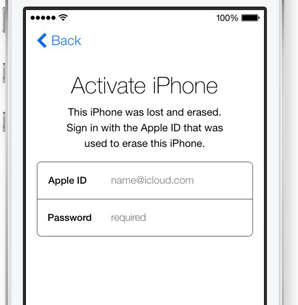
 Two years after energy conservation groups revealed many television set-top boxes use almost as much electricity as a typical refrigerator, a voluntary agreement has been reached to cut the energy use of the devices 10-45 percent by 2017.
Two years after energy conservation groups revealed many television set-top boxes use almost as much electricity as a typical refrigerator, a voluntary agreement has been reached to cut the energy use of the devices 10-45 percent by 2017.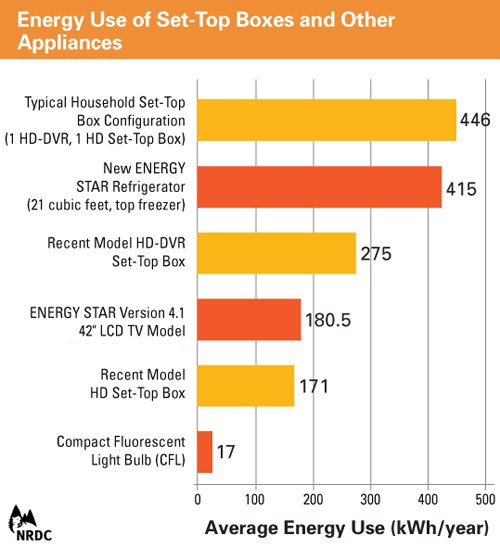

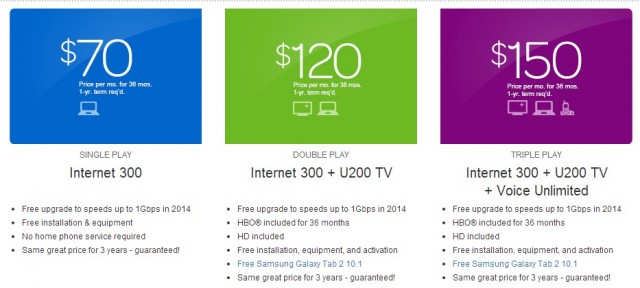
 AT&T has informed Google it will not allow the search engine company to use its utility poles to build a fiber optic network that will compete with AT&T’s own GigaPower fiber service, which launched in Austin this week.
AT&T has informed Google it will not allow the search engine company to use its utility poles to build a fiber optic network that will compete with AT&T’s own GigaPower fiber service, which launched in Austin this week.
